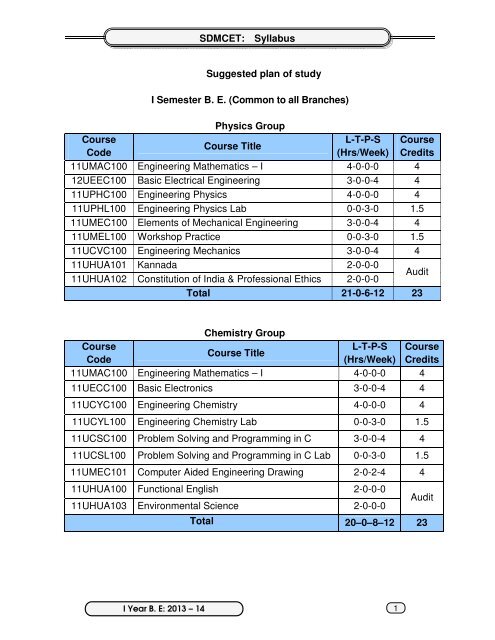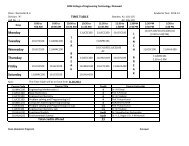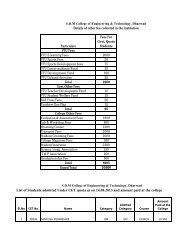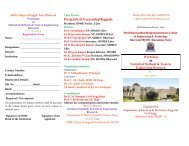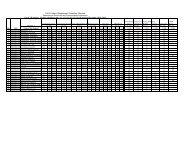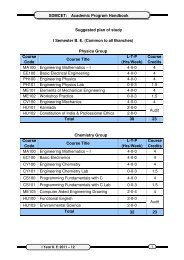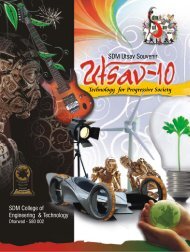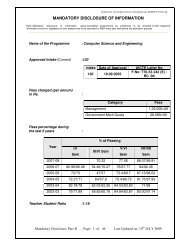SDMCET: Syllabus Suggested plan of study I Semester B. E. ...
SDMCET: Syllabus Suggested plan of study I Semester B. E. ...
SDMCET: Syllabus Suggested plan of study I Semester B. E. ...
Create successful ePaper yourself
Turn your PDF publications into a flip-book with our unique Google optimized e-Paper software.
<strong>SDMCET</strong>: <strong>Syllabus</strong><strong>Suggested</strong> <strong>plan</strong> <strong>of</strong> <strong>study</strong>I <strong>Semester</strong> B. E. (Common to all Branches)Physics GroupCourseL-T-P-S CourseCourse TitleCode(Hrs/Week) Credits11UMAC100 Engineering Mathematics – I 4-0-0-0 412UEEC100 Basic Electrical Engineering 3-0-0-4 411UPHC100 Engineering Physics 4-0-0-0 411UPHL100 Engineering Physics Lab 0-0-3-0 1.511UMEC100 Elements <strong>of</strong> Mechanical Engineering 3-0-0-4 411UMEL100 Workshop Practice 0-0-3-0 1.511UCVC100 Engineering Mechanics 3-0-0-4 411UHUA101 Kannada 2-0-0-011UHUA102 Constitution <strong>of</strong> India & Pr<strong>of</strong>essional Ethics 2-0-0-0AuditTotal 21-0-6-12 23Chemistry GroupCourseL-T-P-S CourseCourse TitleCode(Hrs/Week) Credits11UMAC100 Engineering Mathematics – I 4-0-0-0 411UECC100 Basic Electronics 3-0-0-4 411UCYC100 Engineering Chemistry 4-0-0-0 411UCYL100 Engineering Chemistry Lab 0-0-3-0 1.511UCSC100 Problem Solving and Programming in C 3-0-0-4 411UCSL100 Problem Solving and Programming in C Lab 0-0-3-0 1.511UMEC101 Computer Aided Engineering Drawing 2-0-2-4 411UHUA100 Functional English 2-0-0-011UHUA103 Environmental Science 2-0-0-0AuditTotal 20–0–8–12 23I Year B. E: 2013 – 141
<strong>SDMCET</strong>: <strong>Syllabus</strong>Books:1) E. Hughes - Electrical Technology, 8 th edition, Pearson, 2006.2) B.L. Theraja- Fundamentals <strong>of</strong> Electrical& Electronics Engineering,S Chand,2006.3) R.L. Chakrasali–Basic Electrical Engineering,Acme Learning Pvt. Ltd, New Delhi,2010.4) B.H. Khan – Non Conventional Energy Sources, TMH publishing, 2006.11UPHC100/11UPHC200 Engineering Physics (4-0-0-0) 4Objectives:At the end <strong>of</strong> course, student should understand:1. Failure <strong>of</strong> classical physics in the quantum domain and hence understanding<strong>of</strong> dual nature <strong>of</strong> material particle.2. The fundamentals <strong>of</strong> Quantum Mechanics for comprehending the dynamics <strong>of</strong>sub-atomic particles.3. The basics <strong>of</strong> material parameters that explain the electrical properties <strong>of</strong>metals.4. Energy level concept <strong>of</strong> semiconducting materials and their importantproperties for the solid state device fabrication.5. Physics <strong>of</strong> magnetic and superconducting materials and their applications.6. Photonic materials, devices and their applications.7. The concepts <strong>of</strong> crystal structures and their relations towards understanding<strong>of</strong> crystalline materials.8. Size dependent properties <strong>of</strong> nanomaterials – Elementary concepts,characterizations and applicationsContribution to Outcomes:At the end <strong>of</strong> the semester student should able to demonstrate:1. An ability to analyze the engineering concepts based on fundamental physicalconcepts.2. Applications <strong>of</strong> the fundamental physical laws for better understanding <strong>of</strong>materials and their properties, for engineering applications.Prerequisites: NilContents:1) Modern Physics: Introduction to Modern Physics, Wave particle Dualism, de-Broglie hypothesis- de-Broglie wavelength. Davisson and Germer experiment.Matter waves and their characteristic properties. Concept <strong>of</strong> Phase velocity,group velocity and particle velocity. Relation between group velocity and particleI Year B. E: 2013 – 146
<strong>SDMCET</strong>: <strong>Syllabus</strong>mode and multi mode). Applications: Fiber optic telecommunication and sensors.6 Hrs.7) Crystal Structure: Space lattice, Bravais lattice, Unit cell, Primitive cell, Latticeparameters, Crystal systems, crystal directions and <strong>plan</strong>es, Miller indices,Expression for inter-<strong>plan</strong>ar spacing, Co-ordination number, Atomic packingfactor, Bragg’s law, Determination <strong>of</strong> crystal structure for cubic systems by X-raydiffraction method. Crystal structures <strong>of</strong> Cesium chloride and Diamond. Problemsassociated with cubic structures.7 Hrs.8) Nanomaterials: Size dependent properties at nanomaterials, Classification <strong>of</strong>nanomaterials, Concepts <strong>of</strong> surface energy, quantization <strong>of</strong> energy levels, selfassembly. Variations <strong>of</strong> density <strong>of</strong> states with energy for different dimensions withschematic diagrams. Selected methods for synthesis and characterization <strong>of</strong>nanomaterials (qualitative). Carbon nano-tubes - Properties and Applications.Social implications <strong>of</strong> nanoscience & technology.6 Hrs.Books:1) M. Ali Omar - Elementary <strong>of</strong> Solid State Physics, Addison-Wesley Publications.2) Avadhanalu and Kshirasagar - Engineering Physics, S. Chand Publication3) G.K Shivakumar - Engineering Physics, Prism Books Pvt. Ltd.4) K. Eric Drexler – Nano-systems- Molecular Machinery, Manufacturing andComputation - John Wiely & Sons 2005 Ed.5) Vishwanathan - Nano Materials, Narosa Publications.11UPHL100/11UPHL200 Engineering Physics Lab (0-0-3-0) 1.5List <strong>of</strong> Experiments1. Determination <strong>of</strong> the value <strong>of</strong> Young’s modulus <strong>of</strong> the given wooden bar bysingle cantilever method.2. Determination <strong>of</strong> the wavelength <strong>of</strong> spectral lines in the Hg spectrum using<strong>plan</strong>e diffraction grating by minimum deviation method.3. To <strong>study</strong> the frequency response <strong>of</strong> series and parallel LCR circuits.4. Determination <strong>of</strong> the Fermi Energy <strong>of</strong> a given material.5. Verification <strong>of</strong> Stefan’s Law by electrical method.6. Determination <strong>of</strong> the energy gap <strong>of</strong> a given semiconductor.7. Determination <strong>of</strong> numerical aperture and acceptance angle <strong>of</strong> an optical fiber.8. Determination <strong>of</strong> the dielectric constant <strong>of</strong> a dielectric material by charging &discharging method.9. Study <strong>of</strong> the characteristics <strong>of</strong> a given laser source using diffraction method.10. Study <strong>of</strong> I-V characteristics <strong>of</strong> Zener diode.NOTE: All the 10 experiments are to be conducted.I Year B. E: 2013 – 148
<strong>SDMCET</strong>: <strong>Syllabus</strong>Applications. Brief description (bench and radial drilling machine), Operations ondrilling machines.7 Hrs.6) Milling machines Principle <strong>of</strong> milling, Types, Description and working <strong>of</strong>Horizontal and vertical milling machines. Applications <strong>of</strong> the importantoperations.5 Hrs.7) Welding: Arc welding, Gas welding and Resistance welding (Spot welding),Soldering and Brazing, Applications.4 Hrs.8) Fasteners: Hexagonal and square headed bolts and nuts, screws (countersunkand Allen screws).2 Hrs.9) Power Transmission: Types <strong>of</strong> drives, Belt drives, Ratio <strong>of</strong> tensions (noderivation), Velocity ratio, Power transmitted, derivation for length <strong>of</strong> belt for openand cross belts, problems. Types <strong>of</strong> Gears and their applications. Gear trains.6 Hrs.10) Lubrication and Bearings: Types and properties <strong>of</strong> lubricants, Screw cup andWick lubricators. Introduction <strong>of</strong> Bearings, bush and ball bearings (no Plummerblock).5 Hrs.Topics for self <strong>study</strong>1. Welding soldering and Brazing2. Fastners3. Lubrication and BearingsBooks:1) K. R. GoplaKrishna - Elements <strong>of</strong> Mechanical Engineering, 26th edition, Subhasstores and publishers, 2006.2) K. P. Roy, S. K. Hazra Choudhary and A. K. Hazra Choudhary - Elements <strong>of</strong>Mechanical Engineering, 6th edition, Media Promoters and Publishers, 2003.3) K. R. Gopal Krishna - Machine Drawing, 20th edition, Subhas stores andpublishers, 200711UMEL100/11UMEL200 Workshop Practice (0-0-3-0) 1.5Objective: The objective <strong>of</strong> the course is to make the student aware <strong>of</strong>:1) Workshop practices like carpentry, Fitting Welding and Sheet metal work2) Tools used for efficient working.3) Safety measures to be adopted4) Knowledge <strong>of</strong> First aid in case <strong>of</strong> accidents.Topics: 1) Carpentry.2) Fitting.I Year B. E: 2013 – 1410
<strong>SDMCET</strong>: <strong>Syllabus</strong>3) Sheet metal work.4) Arc welding.Course out come:1) An ability to apply knowledge <strong>of</strong> tools required for getting an object <strong>of</strong>required shape and size2) Accuracy and precession in work.3) Time management.4) Least wastage <strong>of</strong> material and economy in process.5) Proper <strong>plan</strong>ning in sequence <strong>of</strong> jobCourse contents:1) General Introduction to the workshop. 3 Hrs.2) Fitting: Study <strong>of</strong> fitting tools, Study <strong>of</strong> fitting operations and joints, two jobs haveto be completed.15 Hrs.3) Welding: Study <strong>of</strong> electric arc welding tools and equipments, two jobs have to becompleted.6 Hrs.4) Sheet Metal and Soldering: Study <strong>of</strong> sheet metal and soldering toolsDevelopment <strong>of</strong> lateral surface <strong>of</strong> prism, pyramid, cylinder, cone – full andtruncated. Two jobs have to be completed.9 Hrs.5) Demonstration: Carpentry, Study <strong>of</strong> carpentry hand tools and power. 3 Hrs.Books:1) S. K. H. Choudhry, A. K. H. Choudhry, Nirjhar Roy - Elements <strong>of</strong> Workshop, 11thedition, Media Technology – voM Promoters & Publishers, 2001.2) Pr<strong>of</strong> Ravi - Workshop Practice Manual, 1st edition, Best Publishers, 2007.3) Raghuwanshi – Elements <strong>of</strong> Workshop Technology, 1st edition, Dhanpatrai,1981.11UCVC100/11UCVC200 Engineering Mechanics (3-0-0-4) 4Course Objectives:1) To develop a disciplined approach for the application <strong>of</strong> fundamentalprinciples <strong>of</strong> mechanics and physics to model & evaluate particle and rigidbody systems in static equilibrium for unknown forces and moments.2) To understand the practical applications <strong>of</strong> basic principles <strong>of</strong> dynamics.3) To understand vector algebra and to apply the same in solving problems onforces in space.I Year B. E: 2013 – 1411
<strong>SDMCET</strong>: <strong>Syllabus</strong>Course Learning Outcomes:The student1) Will be able to understand the basic laws <strong>of</strong> mechanics and to use vectoralgebra for the description <strong>of</strong> mechanical loads on 3D structural systems.2) Will be able to model and analyze beam internal reactions and machines.3) Will be able to understand and apply concepts <strong>of</strong> frictions.4) Will be able to evaluate properties <strong>of</strong> <strong>plan</strong>e areas which are used in subjects<strong>of</strong> higher semesters.Prerequisites:Students taking this course shall have the knowledge <strong>of</strong> following:1) Basics <strong>of</strong> trigonometry.2) Basics <strong>of</strong> calculus3) Newton’s laws <strong>of</strong> motions.4) Basics <strong>of</strong> friction and leversCourse content:1) Introduction to Engineering Mechanics: Concurrent and non-concurrent forcesystems, Conditions <strong>of</strong> equilibrium, resultant <strong>of</strong> systems, Support reactions forstatically determinate structures.12 Hrs.2) Friction: Types <strong>of</strong> friction, laws <strong>of</strong> dry friction, problems on block, wedge andladder friction, belt friction.6 Hrs.3) Geometrical Properties <strong>of</strong> Planar Elements: Determination <strong>of</strong> Centre <strong>of</strong>Gravity, Moment <strong>of</strong> Inertia <strong>of</strong> <strong>plan</strong>e areas and Radius <strong>of</strong> Gyration for combination<strong>of</strong> geometrical shapes.6 Hrs.4) Forces in Space: Related problems on concurrent and non concurrent forces byVector approach5 Hrs.5) Work, Power and Energy: Work, Power, Energy related problems, Law <strong>of</strong>conservation <strong>of</strong> energy, and momentum.5 Hrs.6) Kinetics: Linear momentum <strong>of</strong> a particle, conservation <strong>of</strong> linear momentum,D’ Alemberts, principle. 6 Hrs.Self <strong>study</strong>:1) Types <strong>of</strong> support – Field examples2) Centre <strong>of</strong> gravity and moment <strong>of</strong> inertia <strong>of</strong> mass.3) Belt drives4) Transmission tower5) Lifting machines like pulley block, Screw Jack, Tripod, Derrick crane,6) Super elevation on roads and etc.I Year B. E: 2013 – 1412
<strong>SDMCET</strong>: <strong>Syllabus</strong>Books:1) Bhavikatti S.S. & Rajashekarappa K.G., ‘Engineering Mechanics’ New AgeInternational (P) Ltd., New Delhi.2) Singer F.L, ‘Engineering Mechanics’ Harper & Row Publication, London.3) Ferdinand P. Beer and E. Russel Johnston Jr., ‘Mechanics for Engineers’McGraw-Hill Book Company, New York.4) Punmia B.C, ‘Engineering Mechanics’, Laxmi Publications, New Delhi.11UHUA101/11UHUA201 Kannada Audit !"# # $%!& $'( )*+,- . / *01-# -2!304 2%(2 $56 "789 :"; < = # /$ >$? $@ 7 ! AB%C D% # EF G2? HI J2% K L $MI NO(P DQ /$K *R &ST N2U V 2"38 )9 J" NW9 2# L :"; 2X%, '&Q EYZ![ I "$P1Z!\] 9 :X # $ $5% 2^ _*Kannada KaliLesson 1:Lesson 2:(Non Kannada students)Part-IIntroducing each otherPersonal Pronouns, Possessive forms, Interrogativewords.About RamayanaPossessive forms <strong>of</strong> nouns, dubitive question, Relativenouns.I Year B. E: 2013 – 1413
<strong>SDMCET</strong>: <strong>Syllabus</strong>Lesson 3:Lesson 4:Lesson 5:Lesson 6:Lesson7:Lesson 8:Lesson 9:Lesson 10:Enquiring about collegeQualitative and quantitative adjectives.Enquiring about roomPredicative forms, locative case.Vegetable MarketDative case, basic numerals.About Medical collegeOrdinal numerals, plural markersIn a cloth shopColor adjectives, defective verbs.Plan to go for picnicImperative, permissive and hortative.About children’s EducationContinuous, Perfect tenses and negationsDiscussing about Examination and future <strong>plan</strong>.Conditional and negative conditions.Part-IIKannada scriptBook:Lingadevaru Halemane - Kannada Kali11UHUA102/11UHUA202 Constitution <strong>of</strong> India and AuditPr<strong>of</strong>essional Ethics1) Preamble to the constitution <strong>of</strong> India Fundamental rights under Part - III details <strong>of</strong>Exercise <strong>of</strong> Rights, Limitations & Important cases.5 Hrs.2) Relevance <strong>of</strong> Directive principles <strong>of</strong> State Policy under Part - IV. Fundamentalduties & their significance.3 Hrs.3) Union Executive President, Prime Minister, Parliament & the Supreme Court <strong>of</strong>India.3 Hrs.4) State executive Governors, Chief Minister, State Legislator and High Courts.3 Hrs.5) Constitutional Provisions for Scheduled Castes & Tribes, Women & Children &Backward classes. Relations between the Union and the States – Legislative andAdministrative.4 Hrs.6) Electoral process, Amendment procedure <strong>of</strong> Constitution. 2 Hrs.7) Scope & aims <strong>of</strong> engineering Ethics. Responsibility <strong>of</strong> Engineers. Impediments toresponsibility.3 Hrs.8) Honesty, Integrity and reliability, risks, safety & liability in engineering. 3 Hrs.I Year B. E: 2013 – 1414
<strong>SDMCET</strong>: <strong>Syllabus</strong>Books:1) Durga Das Basu - Introduction to the Constitution <strong>of</strong> India (Students Edn.),19 th /20 th edition, Prentice - Hall EEE, 2001.2) Constitution <strong>of</strong> India – P M Bakshi3) Charles E. Haries, Michael. S. Pritchard and Michael J. Robins - EngineeringEthics, Thompson Asia, 2003.4) M. V. Pylee - An Introduction to Constitution <strong>of</strong> lndia, Vikas Publishing, 2002.5) M. Govindarajan, S.Natarajan, V.S.Senthilkumar - Engineering Ethics, Prentice -Hall <strong>of</strong> India Pvt. Ltd., 2004.11UECC100/11UECC200 Basic Electronics (3–0–0-4) 4Course Objectives:1. To <strong>study</strong> basic electronic devices like PN-junction diode, Zener diodes, and itsapplications, BJT, Biasing Circuits2. Study <strong>of</strong> OP-Amps, Basic <strong>of</strong> Signal & Systems, and Communication systems.3. Study <strong>of</strong> Basic <strong>of</strong> Digital Circuits.Course outcomes:1. Understanding the fundamentals <strong>of</strong> electronics –(PO-a,b)2. Has the knowledge <strong>of</strong> electronic devices and its applications –(PO-b,c,i)3. Ability to design and analyze the circuits –(PO-b,c,i)4. Ability to apply their knowledge to solve electronics engineering problems. –(PO-g,j,k)Prerequisite:1. Basics <strong>of</strong> Semiconductor Theory, Classification <strong>of</strong> materials, AtomicModels.Course contents:1) Applications <strong>of</strong> Electronics & Communication Engineering. 2Hrs.2) Basics <strong>of</strong> Digital Circuits: Brief introduction to number system, Binary, Octal,Hexadecimal number system, Addition and Subtraction, Fractional number,Boolean algebra, Half Adder, Full adder, Half subtractor and Full subtractor,Parallel Binary Adder.9 Hrs.3) Semiconductor Diodes and Applications: Review <strong>of</strong> semiconductor theory, p-n junction diode characteristics, DC load line, Half Wave and Full wave DiodeRectifier without and with Capacitor Filter, Zener diode and Voltage regulator withvarying input and varying load.11 Hrs.I Year B. E: 2013 – 1415
<strong>SDMCET</strong>: <strong>Syllabus</strong>Course Outcomes:• Concepts <strong>of</strong> electrochemical reactions involved in different fields <strong>of</strong>engineering.• Diverse applications <strong>of</strong> modern batteries.• New techniques to control the corrosion to the greater extent.• Alternate fuels using non-exhaustible biomass.• Advance polymers having diverse applications.• Applications <strong>of</strong> phase rule to know the equilibria existing in heterogeneoussystems.• Different parameters <strong>of</strong> water to know the quality <strong>of</strong> water for differentpurposes.• Cementing materials for hightech applications.Contents:1) Electrochemistry: Introduction, Electrode potential & its origin, Standardelectrode potential, Derivation <strong>of</strong> Nernst equation for electrode potential;Electrochemical conventions--representation <strong>of</strong> electrode potential as reductionpotential, Sign <strong>of</strong> the electrode potential, representation <strong>of</strong> electrode & cell,electrode reaction and cell reaction, calculation <strong>of</strong> cell potential; Construction &working <strong>of</strong> Galvanic cell. Numerical problems on E, E 0 , E 0 cell, E cell, [M n+ ];Electrolyte concentration cell-Numerical problems. Reference electrodes-Limitations <strong>of</strong> SHE, advantages <strong>of</strong> secondary reference electrodes;Construction, working & applications <strong>of</strong> Calomel electrode, measurement <strong>of</strong>single electrode potential using calomel electrode; Ion-selective electrodes—classification; Glass electrode– Construction & derivation <strong>of</strong> electrode potential,Measurement <strong>of</strong> pH <strong>of</strong> a solution using glass electrode.7 Hrs.2) Battery Technology: Introduction, Classification -- Primary & Secondary;Reserve batteries; Characteristics (cell potential, current, capacity, electricitystorage density, energy efficiency, shelf life & cycle life); Construction, working& applications <strong>of</strong> Lead-acid battery, Zinc-air battery, Ni-Cd battery and Li-MnO 2battery; Fuel cells– introduction, difference between conventional cell and afuel cell, limitations, advantages; Types <strong>of</strong> fuel cells, Construction & working <strong>of</strong>hydrogen- oxygen fuel cell and methanol - oxygen fuel cell with H 2 SO 4electrolyte.6 Hrs.3) Corrosion and its Control: Introduction, Chemical & Electrochemical theories<strong>of</strong> corrosion; Galvanic Series; Factors affecting corrosion rate (Nature <strong>of</strong> themetal, relative areas <strong>of</strong> anode and cathode, nature <strong>of</strong> the corrosion product,Nature <strong>of</strong> the medium--conductivity, pH & temperature); Types <strong>of</strong> corrosiongalvanic,differential aeration(waterline), pitting & stress; Corrosion controldesignand selection <strong>of</strong> material, protective coatings - metal coatings(anodic &I Year B. E: 2013 – 1417
<strong>SDMCET</strong>: <strong>Syllabus</strong>cathodic), inorganic coatings(anodized & phosphate), cathodic protection(sacrificial & impressed current methods) & anodic protection. 6 Hrs.4) Chemical Energy Sources: Fuels--Introduction, Classification, Calorific value,Determination <strong>of</strong> calorific value using Bomb calorimeter, Numerical problems,Cracking—Introduction, fixed bed and fluidized bed catalytic cracking;advantages <strong>of</strong> moving bed catalytic cracking over fixed bed catalytic cracking,Synthesis <strong>of</strong> petrol by Bergius process & Fishcher-Tropsch process, Reforming<strong>of</strong> petrol—significance & reactions; gasoline & diesel knocking & theirmechanism, , anti knocking agents; unleaded petrol; Octane number; Cetanenumber; Power alcohol & Biodiesel.7 Hrs.5) High Polymers: Introduction, Types <strong>of</strong> polymerization – Addition andcondensation polymerization with examples; Methods <strong>of</strong> polymerization- bulk,solution, suspension and emulsion; Mechanism <strong>of</strong> polymerization - Free radicaltaking ethylene as a monomer; Glass Transition temperature, factorsinfluencing T g –flexibility, inter molecular forces, branching and cross-linking,molecular mass, stereo regularity and presence <strong>of</strong> plasticizers; Significance <strong>of</strong>T g ; Synthesis, properties & applications <strong>of</strong> Polycarbonate, Polymethylmethacrylate and Polyurethane; Elastomers—introduction, synthesis, &applications <strong>of</strong> butyl rubber and silicone rubber. Adhesives--introduction,synthesis, & applications <strong>of</strong> epoxy resins; conducting polymers- Introduction,Synthesis and applications <strong>of</strong> conducting polyaniline.7 Hrs.6) Water Technology: Introduction, sources and impurities <strong>of</strong> water; Hardness <strong>of</strong>water, Units <strong>of</strong> Hardness, Determination <strong>of</strong> Hardness and Alkalinity. Numericalproblems on hardness and alkalinity. Determination <strong>of</strong> Chloride & Fluoride.Determination <strong>of</strong> DO, COD, BOD, Numerical problems on BOD & COD,Desalination <strong>of</strong> water- Multistage flash evaporation, Reverse osmosis and Ionselective Electrodialysis method.6 Hrs.7) Phase Equilibria: Phase rule – statement, Terms- definition and ex<strong>plan</strong>ation<strong>of</strong> phase, component and degree <strong>of</strong> freedom. Applications <strong>of</strong> phase rule overone component systems- water system, over two component systems- types<strong>of</strong> equilibria, Lead- silver system Formation <strong>of</strong> compounds with congruentmelting points: Ferric chloride- water system, with incongruent melting points:Sodium sulphate – water system.5 Hrs.8) Inorganic cementing materials:a) Cement: Classification- Natural, puzzolana, slag, Portland and special cements.Portland cement- Raw materials, manufacture by wet and dry processes,chemical constitution <strong>of</strong> Portland cement. Setting and hardening <strong>of</strong> Portlandcement, functions <strong>of</strong> gypsum in cement.b) Refractories: Definition, physical and chemical characteristics-Refractoriness,strength, spalling, thermal conductivity, Chemical porosity and chemicalcomposition. Classification- Acidic, basic and neutral. Preparation, propertiesI Year B. E: 2013 – 1418
<strong>SDMCET</strong>: <strong>Syllabus</strong>and uses <strong>of</strong> silica, magnesite, carbon, and carborundom.6 Hrs.Books:1) Jain P.C. & Monika Jain, Engineering Chemistry, Dhanpat Rai & Sons, Delhi.2) A Text Book <strong>of</strong> Engineering Chemistry – M.M. Uppal, Khanna Publishers.3) Puri B.R., Sharma L.R. and M.S. Pathania, Principles <strong>of</strong> Physical Chemistry, S.N.Chand & Co., Jalandhar.4) J.C. Kuriacose, J. Rajaram, Chemistry in Engineering and Technology, Volume I& II, Tata McGraw-Hill Publishing Company Limited, New Delhi.5) R. Narayan & B. Vishwanathan, Chemical and Electrochemical Energy Systems,Universities Press (India) Limited.6) Mars G. Fontana, Corrosion Engineering, McGraw-Hill International Edition.7) Gowarikar V.R., Viswanathan, N.V. & Jayadev Shreedharan, Polymer Science,New Age International Publishers.8) Billmeyer F.W., Textbook <strong>of</strong> Polymer Science, John Wiley & Sons.9) Will Mitchell J.R., Fuel Cells, Academic Press, New York and London.10) C.D. Verghese, Electroplating and other surface treatments, Tata McGraw-HillPublishing Company Ltd.11UCYL100/11UCYL200 Engineering Chemistry Lab (0–0–3-0) 1.5List <strong>of</strong> ExperimentsVolumetry:1) Estimation <strong>of</strong> total hardness <strong>of</strong> water by EDTA method.2) Determination <strong>of</strong> alkalinity (hydroxide, carbonate and bicarbonate) <strong>of</strong> watersample.3) Estimation <strong>of</strong> calcium present in the given sample <strong>of</strong> cement solution by EDTAmethod.4) Estimation <strong>of</strong> percentage <strong>of</strong> copper in brass by iodometric method.5) Estimation <strong>of</strong> amount <strong>of</strong> iron in haematite ore solution by external indicatormethod.Instrumental:1) Estimation <strong>of</strong> hydrochloric acid & acetic acid from their mixture conductometrically.2) Estimation <strong>of</strong> FAS Potentiometrically.3) Estimation <strong>of</strong> copper colorimetrically.4) Determination <strong>of</strong> pK a value <strong>of</strong> a given weak acid using pH-meter.5) Determination <strong>of</strong> viscosity coefficient <strong>of</strong> a given liquid using Ostwald’sviscometer.I Year B. E: 2013 – 1419
<strong>SDMCET</strong>: <strong>Syllabus</strong>Books:1) Willard, H.H., Merritt, L.L., Dean, J.A., and Settle, F.A., "Instrumental Methods <strong>of</strong>Analysis", Wadsworth Publishing Company.2) Vogel A.I., Text Book <strong>of</strong> Quantitative inorganic Analysis, ELBS Publication.3) O. P. Varmani & A. K. Narula, Applied Chemistry, New Age InternationalPublishers.4) J.B. Yadav, Advanced practical physical chemistry, Goel Publishing House.5) P.C.Kamboj systematic practical chemistry- Vishal publications. Jalandhar Delhi.11UCSC100/11UCSC200 Problem Solving and (3–0–0-4) 4Programming in CCourse Objectives:At the end <strong>of</strong> the course, the student should:1. Acquire the ability to analyze the given problem in scientific, engineering andbusiness domains and model the solution using flowchart and algorithm.2. Understand writing C program using simple primitives, control structures anddecision making constructs.3. Understand writing complex C program using arrays, structures, unions,pointers and file operations.4. Understand writing modular programs using functions and parameter passingtechniques. Use <strong>of</strong> recursion in writing programs.5. Understand basic debugging and testing techniques.6. Understand Industry standard programming styles and practices.Course Outcomes:At the end <strong>of</strong> the course student should be able to:1. Analyze problem domain and design the solution for a given problem andrepresent the solution in the form <strong>of</strong> flowchart/algorithm (PO B).2. Writing modular and efficient C programs for various scientific, engineeringand business domains (PO E).3. Demonstrate a) verification and validation <strong>of</strong> the program correctness b) Use<strong>of</strong> good programming practices required in the industry (PO K).Course Contents:1) Flow-Chart and Algorithm: Solving various scientific, engineering and businessrelated problems <strong>of</strong> varying complexity.3 Hrs.2) Fundamentals <strong>of</strong> C Programming Language: Program structure andexecution. Character set, Data types, operators, expression evaluation. Simpleand Compound Statements. Type Conversion.5 Hrs.I Year B. E: 2013 – 1420
<strong>SDMCET</strong>: <strong>Syllabus</strong>3) Control Structures: If Statement and its different forms, Switch Statement,Loops and their behavior.8 Hrs.4) Arrays and Strings: Single and multidimensional arrays and their applications,Advantages and disadvantages <strong>of</strong> arrays, Character arrays and theirapplications.8 Hrs.5) Modular Programming and Recursion: Declaration, definition and use <strong>of</strong>functions. Passing parameters to function. Use <strong>of</strong> recursion.8 Hrs.6) Building Blocks <strong>of</strong> Data Structure: Arrays (revisited), Structures, Unions,Pointer, and File Operations.8 Hrs.Self Learning Components (4 hours per week, 1 credit):Each course teacher must design self learning component based on the objectivesand expected outcomes defined for the course and take prior approval <strong>of</strong> DUGCbefore putting them on practice.Books:1) Programming in ANSI C by E Balagrusamy, TMH 3 rd Edition.2) The programming language C by Brian W. Kernighan & Dennis M.Ritchie, 2 nd Edition PHI 2004 .3) How to solve it by computer by Dromey R. G, PHI 2001.4) The Practice <strong>of</strong> Programming by Brain W. Kernighan and Rob Pike, PEI 2004.11UCSL100/11UCSL200 Problem Solving and (0–0–3-0)1.5Programming in C LabCourse Objective:At the end <strong>of</strong> the laboratory course student should demonstrate:1. Problem solving ability.2. Code reviewing Skills.3. Code debugging Skills.Laboratory Exercises:Problem solving using flowchart, algorithm and programming in C in business,scientific and engineering applications. This includes exercise on each <strong>of</strong> thefollowing list <strong>of</strong> suggested sections:Bit-wise operators, Modular programming, Searching, Sorting, NumericalTechniques, Mathematical series, Matrix operations, String manipulations, Filehandling, pointers , Structures and Unions.Working Platform: Linux Operating SystemI Year B. E: 2013 – 1421
<strong>SDMCET</strong>: <strong>Syllabus</strong>Coding Practice1. Use <strong>of</strong> Good Programming practices: Declaration <strong>of</strong> variables, Indentation,Documentation, Simplicity <strong>of</strong> logic, Efficiency <strong>of</strong> logic, uniformity etc.2. Generic and Reusable code.3. Inclusions <strong>of</strong> exceptional cases.4. Better usability.11UMEC101/11UMEC201 Computer Aided Engineering Drawing (2–0–2-4) 4Course Objectives: Comprehend general projection theory, with emphasis on orthographicprojection to represent in two-dimensional views (principal, auxiliary,sections). Dimension and annotate two-dimensional engineering drawings. Understand the application <strong>of</strong> industry standards and best practices applied inengineering graphics. Emphasize freehand sketching to aid in the visualization process and toefficiently communicate ideas graphically. Introduction <strong>of</strong> CAD s<strong>of</strong>tware for the creation <strong>of</strong> 2D engineering drawings. The theoretical concepts delivered in this course would help the students tounderstand the design considerations and tolerances to be used in the designand manufacture <strong>of</strong> engineering components. This course will be very much basics for students to learn and wisely apply forthe advanced Computer Aided Engineering (CAE) tools such as ABAQUS,ANSYS etc.Pre-requisites: Familiarity <strong>of</strong> basics <strong>of</strong> Planar/Solid/Analytical Geometry and its constructions Trigonometry Students should have basic computer skills (how to use computer)Programme Outcomes: Be industry ready Be able to develop independent thinking and problem solving capabilities Be able to express component descriptions as per the commonly practicedstandards Be able to produce 2D and simple 3D drawings Be able to comprehend industry specific drawings Be able to converse through computer aided drawing any objects/tools/instruments/elements/structures belonging to the entire engineering fieldI Year B. E: 2013 – 1422
<strong>SDMCET</strong>: <strong>Syllabus</strong> Be able to produce simple clear and illustrative drawings as per existingstandards / conversations.Course Contents: Symbols and standards as applied in Engineering and Freehand drawing as atool for visualization. Introduction to geometrical construction and CAD s<strong>of</strong>tware Principles <strong>of</strong> drawing, principles <strong>of</strong> orthographic projections sections, auxiliaryviews and conventional practices. Introduction to descriptive geometry. Hand and computer-aided drawing. Projections <strong>of</strong> points, lines, <strong>plan</strong>es and solids Section <strong>of</strong> solids and development <strong>of</strong> solids Isometric projections and application drawingsMapping <strong>of</strong> Programme Educational Objectives (PEOs) to Programme Outcomes(a) An ability to apply knowledge <strong>of</strong> mathematics, science, and engineering,(d) An ability to function on multidisciplinary teams,(e) An ability to identify, formulate, and solve engineering problems,(g) An ability to communicate effectively,(i) A recognition <strong>of</strong> the need for, and an ability to engage in life-long learning,(k) An ability to use the techniques, skills, and modern engineering tools necessaryfor engineering practice.Course contents:1) Introduction to Engineering Drawing: Introduction, Drawing Instruments andtheir uses, BIS conventions, Drawing sheets, Lettering, Dimensioning, Scales,regular polygons and its methods, tangents, ellipse, parabola, hyperbola, loci,cycloids, trochoids, epi and hypocycloids, spirals and involutes, helix, Co-ordinatesystem and reference <strong>plan</strong>es.2 Hrs.2) Introduction to S<strong>of</strong>tware (solid edge): Computer screen, layout <strong>of</strong> the s<strong>of</strong>tware,standard tool bar/menus and description <strong>of</strong> most commonly used tool bars,navigational tools Creation <strong>of</strong> 2D/3D environment. Selection <strong>of</strong> drawing size andscale. Commands and creation <strong>of</strong> Lines, Co-ordinate points, axes, poly-lines,square, rectangle, polygons, splines, circles, ellipse, text, move, copy, <strong>of</strong>f-set,mirror, rotate, trim, extend to next, split, chamfer, fillet, curves, constraints viz.tangency, parallelism, inclination and perpendicularity. Dimensioning, lineconventions, material conventions and lettering.2 Hrs.3) Solid Geometry: Introduction, Definitions - Planes <strong>of</strong> projection, reference lineand conventions employed, Projections <strong>of</strong> points in all the four quadrants,Projections <strong>of</strong> straight lines (located in First quadrant/first angle only), True andI Year B. E: 2013 – 1423
<strong>SDMCET</strong>: <strong>Syllabus</strong>apparent lengths, True and apparent inclinations to reference <strong>plan</strong>es (Noapplication problems).10 Hrs.4) Orthographic Projections <strong>of</strong> Plane Surfaces: (First Angle Projection Only)Introduction, Definitions–projections <strong>of</strong> <strong>plan</strong>e surfaces (lamina) – triangle, square,rectangle, pentagon, hexagon and circle, <strong>plan</strong>es in different positions by change<strong>of</strong> position method only (No problems on punched plates and composite plates).10 Hrs.5) Projections <strong>of</strong> Solids: (First angle Projection only) Introduction, Definitions –Projections <strong>of</strong> right regular cube, prisms, pyramids, cylinders and cones indifferent positions (No problems on octahedrons and combination solid). 16 Hrs.6) Sections and Development <strong>of</strong> Lateral Surfaces <strong>of</strong> Solids: Introduction, Section<strong>plan</strong>es, Sections, Sectional views, Apparent and True shapes <strong>of</strong> Sections <strong>of</strong> rightregular prisms, pyramids, cylinders and cones resting with base on HP.Development <strong>of</strong> lateral surfaces <strong>of</strong> above solids, their frustums and truncations.(No problems on lateral surfaces <strong>of</strong> trays, tetrahedrons, spheres and transitionpieces).10 Hrs.7) Isometric Projection (Using Isometric Scale Only): Introduction, Isometricscale, Isometric projection <strong>of</strong> simple <strong>plan</strong>e figures, Isometric projection <strong>of</strong>hexahedron (cube), right regular prisms, pyramids, cylinders, cones, spheres, cutspheres and combination <strong>of</strong> solids (Maximum <strong>of</strong> three solids) or solid parts.10 Hrs.8) Application Drawings: Civil drawing (building <strong>plan</strong>s), electrical symbols andcircuits, electronic symbols and circuits and simple assembly drawing (bolt andnut).10 Hrs.Topics for self <strong>study</strong>1. Projection <strong>of</strong> solids hexagonal prism and hexagonal pyramid2. Developments <strong>of</strong> sectional solids3. Application drawingsBooks:1) Engineering Drawing - N.D. Bhatt & V.M. Panchal, 48th edition, 2005-CharotarPublishing House, Gujarat.2) A Primer on Computer Aided Engineering Drawing-2006, Published by VTU,Belgaum.3) Computer Aided Engineering Drawing - S. Trymbaka Murthy, - I .K. InternationalPublishing House Pvt. Ltd., New Delhi, 3rd revised edition- 2006.4) Engineering Graphics - K.R. Gopalakrishna, 32nd edition, 2005- SubashPublishers Bangalore.I Year B. E: 2013 – 1424
<strong>SDMCET</strong>: <strong>Syllabus</strong>11UHUA100/11UHUA200 Functional English AUDITIntroduction: Importance <strong>of</strong> English and s<strong>of</strong>t skills in the global and Indian scenario,relation to employability-campus recruitment procedures.Introduction to English grammar: Parts <strong>of</strong> speechNouns: Types- abstract, collective, common and proper nounsNoun: Gender, number and possessive caseRules <strong>of</strong> punctuation and capitalsRules <strong>of</strong> usage for articles: Definite and indefinite – the sound system in English,vowels and consonantsPrepositionsTensesVocabulary: Homonyms and homophones, one-word equivalents, idioms andphrases, using newspapers to build vocabularyDescribing things and people: shapes, tools, actions, physical characteristics,behavioural traits, ailments and feelings.Framing questionsComposition: précis writing, essay writing, report writing, letter writing, preparingCVSpoken communication: Description <strong>of</strong> pictures, narration <strong>of</strong> videos and answeringquestions based on videosPresentation skills: Preparation and delivery – steps, non-verbal communication,understanding the target audience-demographics and psychographics. Thepsychology <strong>of</strong> presentations - confidence on stageCommon errors in usageBooks:1) English Grammar – Wren & Martin, 19992) S L N Sharma & K. Shankaranarayana – Basic Grammar, NavakarnatakaPublications, 2002.3) Intermediate English Grammar – (with answers) – Raymond Murphy. CambridgeUniversity Press4) Leo Jones & Richard Alexander – New International Business English,Cambridge University Press, 2003I Year B. E: 2013 – 1425
<strong>SDMCET</strong>: <strong>Syllabus</strong>11UHUA103/11UHUA203 Environmental Science AUDITPart-A1) Environment: Definition, Component <strong>of</strong> environment and its interaction. Concept<strong>of</strong> ecosystem and its management. Human activities – Food, Shelter, Economicand Social Security. Techno ecosystem: definition, evolution, comparisonbetween natural ecosystem and techno ecosystem.3 Hrs.2) Effects <strong>of</strong> human activities on environment: Agriculture, Housing, Industry,Mining and Transportation activities, Environmental Impact Assessment.Sustainable Development.3 Hrs.3) Natural Resources: Definition, Types, Water resource, Hydrological cycle, waterquality indicators, Fluoride problem in drinking water, water borne and induceddisease, municipal waste water treatment, , Mineral Resources, ForestWealth, Material Cycles – Carbons, Nitrogen and Sulphur Cycles. 4 Hrs.4) Energy in ecological system: Fundamental concept related to energy,Electromagnetic spectrum, classification <strong>of</strong> energy resources, Hydro Electric,Fossil fuel base, Nuclear, Solar, Biomass and Bio-gas, Hydrogen as analternative future source <strong>of</strong> Energy.4 Hrs.5) Environmental Pollution and their effects: Water pollution, Land pollution andNoise pollution. Chemical toxicology: Biochemical effect <strong>of</strong> CO, PAN, Cyanide.3 Hrs.Part-B6) Current Environmental issues <strong>of</strong> importance: Population Growth, Climatechange and Global warming – Effects, Urbanization, Automobile pollution.3 Hrs.7) Acid rain, Ozone layer depletion, Animal Husbandary. 3 Hrs.8) Environmental Protection – Role <strong>of</strong> Government, Legal aspects, Initiatives byNon- Governmental Organizations (NGO), Environmental Education,Women Education.3 Hrs.Books:1) D. K. Asthana – Environmental Studies, 1 st edition, S. Chand & Co., 2006.2) P. Venugopala Rao - Principles <strong>of</strong> Environmental Science and Engineering,Prentice Hall <strong>of</strong> India, 20053) Meenakshi - Environmental Science and Engineering, Prentice Hall India, 2005.4) A K De – Environmental Science.I Year B. E: 2013 – 1426
<strong>SDMCET</strong>: <strong>Syllabus</strong>11UMAC200 Engineering Mathematics – II (4–0–0-0) 4Course Objectives: The program educational objectives for the Engineering , are important forsuccessful pr<strong>of</strong>essional practice and the ability to pursue advanced degrees. The student will be prepared to: Use technical, team work and communicationskills along with leadership principles to pursue Maths in areas such asstructural, transportation, environmental electric circuits, heat conduction andvibrating strings and other fields. Engage in life – long learning through independent <strong>study</strong> and by participatingin pr<strong>of</strong>essional conferences, workshops, seminars or continuing education.Contribution to Outcomes:At the time <strong>of</strong> graduation, Engineering Mathematics graduates are expected: An ability to apply knowledge <strong>of</strong> Mathematics An ability to understand differential calculus, integrated calculus, differentialequations,vector differentiation and vector integration and apply them toengineering applications. An ability to understand Laplace transform and inverse Laplace transform andapply them to many engineering applications. An ability to identify, formulate and solve engineering problems.Course Contents:1) Differential equation (I): Introduction, Linear and Bernoulli’s equations, Exactequations and reducible to exact form. Application <strong>of</strong> ODE’S to find orthogonaltrajectories and electrical circuits.8 Hrs.2) Differential Equations (II): Linear differential equations <strong>of</strong> 2nd and higher orderwith constant coefficients, Method <strong>of</strong> variation <strong>of</strong> parameters and solutions <strong>of</strong>Cauchy’s homogenous linear equations, Legendre’s linear differential equations,solutions <strong>of</strong> Engineering problems: Electric circuits, simple harmonic motion.10 Hrs.3) Laplace Transforms: Definitions, Laplace transform <strong>of</strong> elementary functions,properties, periodic function, unit step function. Illustrations, examples. 10 Hrs.4) Inverse Laplace Transforms: Definition <strong>of</strong> Inverse Laplace transform,convolution theorem, Solutions <strong>of</strong> ordinary differential equations andsimultaneous differential equations. Applications to Engineering problems-Vibrations <strong>of</strong> a string, LRC circuits.10 Hrs.5) Vector Differentiation: Scalar and Vector point functions, Velocity, Acceleration.The vector differential operator, Gradient, Geometrical interpretation <strong>of</strong> gradientI Year B. E: 2013 – 1427
<strong>SDMCET</strong>: <strong>Syllabus</strong>Directional Derivative. Divergence, Geometrical interpretation <strong>of</strong> divergence,Solenoidal vector and Curl. Geometrical interpretation <strong>of</strong> Curl, IrrotationalVectors and Vector Identities.8 Hrs.6) Vector Integration: Line, Surface and volume integrals- Definition and problems.Green’s theorem in a <strong>plan</strong>e, Stoke’s and Gauss divergence-theorem (withoutpro<strong>of</strong>s) Applications.6 Hrs.Books:1. Grewal B.S, Highes, Engineering Mathematics, 40th Edn, KhannaPublications, New Delhi-20072. Kreyszig, E, Advanced Engineering Mathematics, 8 th Edn. John Wiley &Sons, 2004.3. Bali and Iyengar, A text book <strong>of</strong> Engineering Mathematics, 6 th Edn. Laxmipublications (P) Ltd. New-Delhi, 20034. A.R.Desai. A text book <strong>of</strong> Engineering Mathematics-I & III Year B. E: 2013 – 1428


